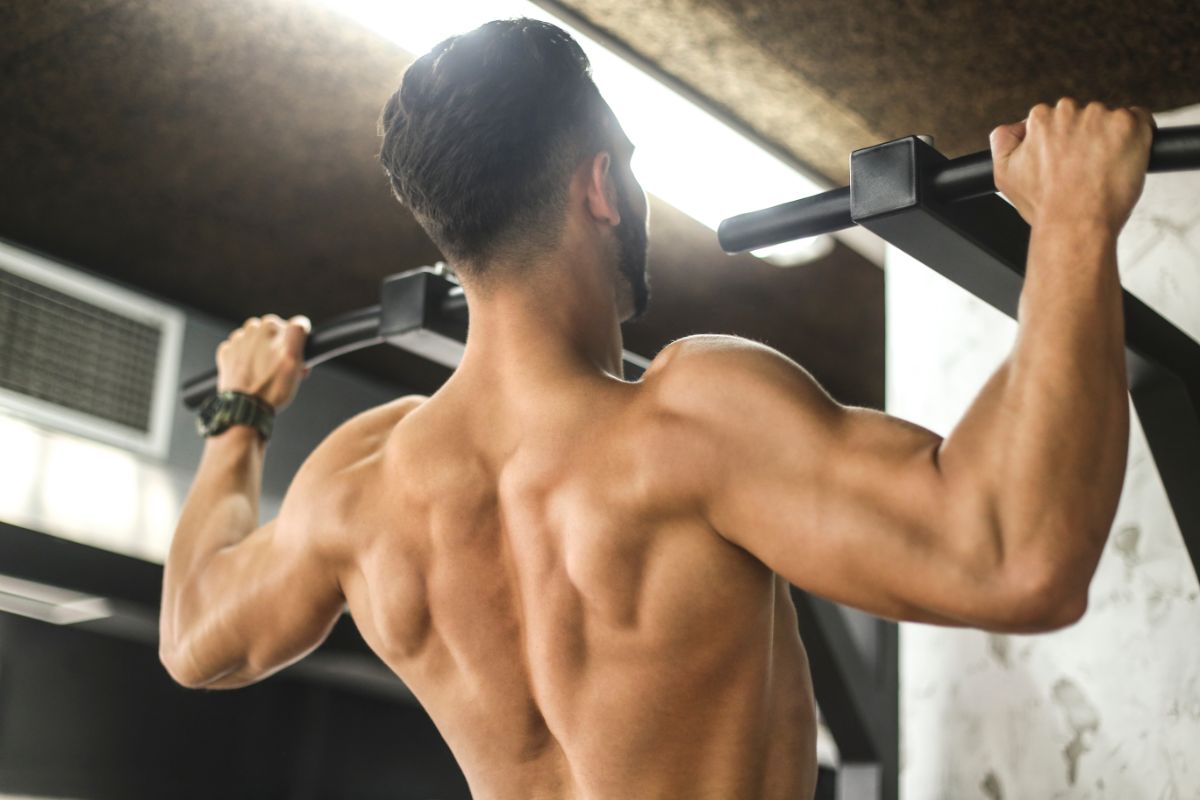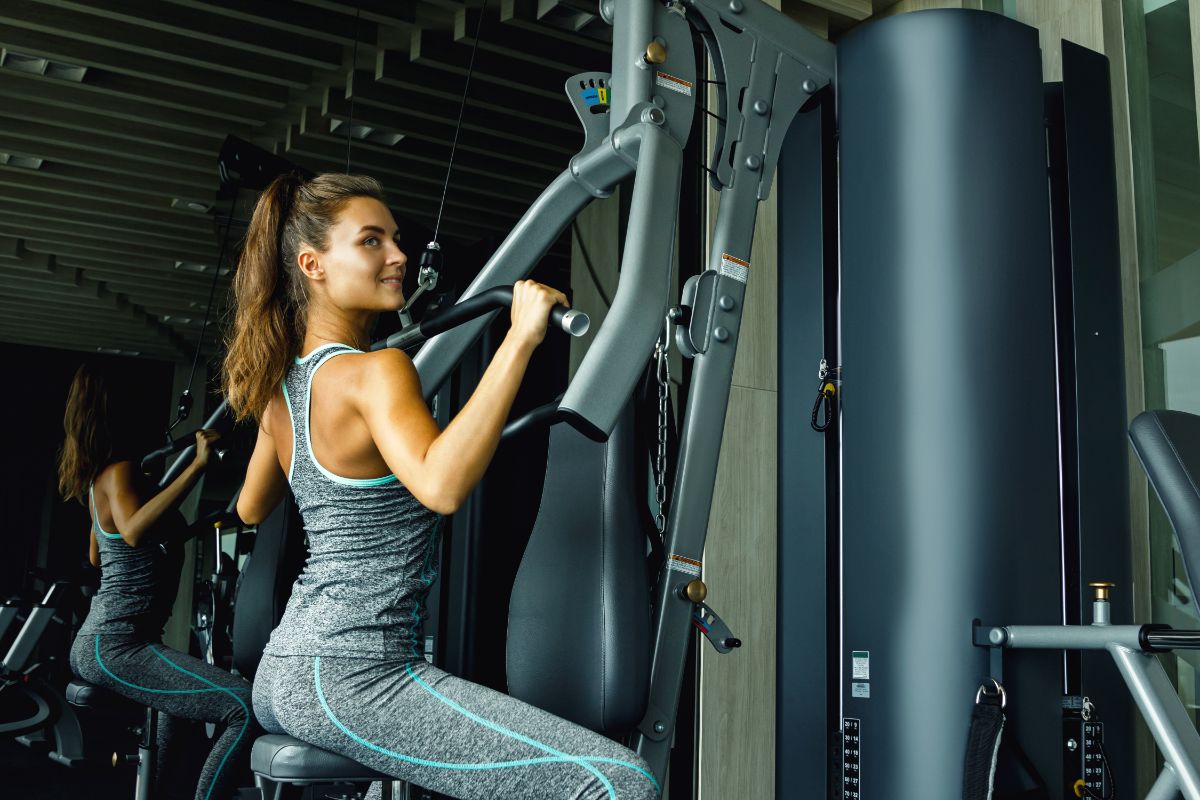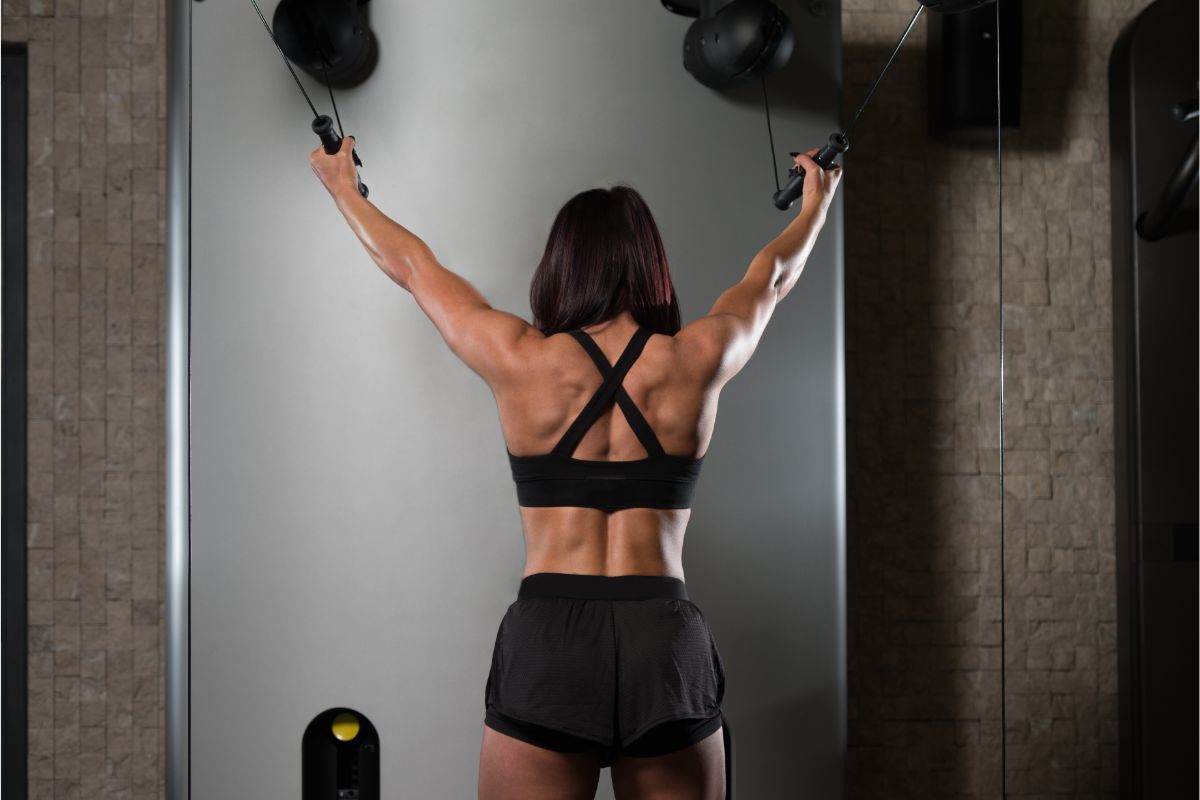Last Updated on December 5, 2022 by admin
Getting that nice defined, Dorito shaped back can be achieved through sets upon sets of push ups. Or you can build yourself an effective, well-structured back workout. That is why its important to understand the best exercises for back training.
In the past it has been common for the back and legs to be neglected. Meaning that while your chest, arms, and abs are popping, your other muscles are extremely lacking.
Ready to make a change?
We have created this incredible back workout routine. From how to perform each exercise correctly to the necessary rest required in order to achieve the results you want, we include everything you need to know to build a chiseled, functioning back!
Keep reading to find out more!
The 4 Main Muscle Groups
Before we can get into the specific exercises required to build a strong back, it is important to know which muscles are being targeted.
These muscle groups can be broken down into:
The Lats
The middle and lower back’s width is covered by the broad, flat latissimus dorsi muscle. It joins the hip and the upper arm’s bone to the spine. The lats are a common name for this muscle.
This is where the majority of the strength comes from in the back and provides that wide “winged” look to the back.
The latissimus dorsi muscle is a member of the muscles that control scapular mobility. This muscle can produce movements on the shoulder joint, including internal rotation, adduction, and extension of the arm.
It can pull the inferior angle of the scapula in a variety of ways. It is also an auxiliary respiratory muscle and one of the spine’s primary stabilizers during its varied movements.
Rhomboids
The rhomboids are a pair of interconnected muscles. The stability of the scapula and shoulder girdle as well as the movement of the upper limbs depend on the rhomboids.
The dorsal scapular nerve innervates the rhomboids, while the dorsal scapular artery supplies blood to both of them.
The rhomboids are located directly above the lats towards the spine. Scapular retraction around the scapulothoracic joint is the primary function of the rhomboid muscles.
Scapular retraction is the simultaneous superior and medial sliding of the scapula down the trunk.
The glenoid cavity rotates inferiorly as a result of the scapula’s superomedial movement, descending the shoulder girdle. The rhomboids support maintaining proper posture while sitting, standing, and walking by resisting excessive scapular protraction.
The Traps
The muscle known as the trapezius runs from the base of the neck to the middle of the back, passing through the shoulders.
You may move your head, neck, arms, shoulders, and torso with the aid of the trapezius (traps muscle). Additionally, it supports spinal stability and improves posture.
Erector Spinae (Lower Back)
The middle layer of the deep (intrinsic) muscles of the back is made up of the erector spinae muscles. They stretch between the superior end of the pelvis and the inferior end of the base of the skull on either side of the spinal column.
From medial to lateral, the erector spinae are separated into three groups: spine-related muscles
Best Exercises For Working The Back Muscles

Now that we have covered the main muscle groups you are going to target, we can get into the most important exercises you will be performing.
Each exercise will aid in growing your back and enhancing your performance not only in the gym but in everyday life.
1. Warm Up
Like any other workout, the warm up is just as important or even more important than the workout itself.
You want to take the time to complete a 5-10 minute warm up program to ensure the muscles, tendons, and joints are loose and have blood pumping around them.
This allows you to work more effectively and reduce the risk of injury.
Your warm up should include 5-10 minutes of moderate cardio. This can be a slight job, walking, cycling, rowing, etc. Then, a short dynamic stretching routine should be completed.
2. Pull Ups & Chin Ups
When you enter the gym you may see some experts doing pull ups with chains and weights. This can be daunting but body weight pull ups or even assisted pull ups are going to work out your entire back and even your biceps!
You should try both pull-ups and chin-ups in your training regimen since research indicates that they both give the same level of lat activation.
The pull-up will focus on activation in your lower traps and infraspinatus, whereas the chin-up will stimulate more of your pecs and biceps, according to the research.
As a beginner, you may not be able to complete body pull ups. If your local gym has a pull up machine, then take advantage! Before moving on to bodyweight pull-ups, concentrate on performing repetitions that are controlled and in the entire range of motion.
Alternatively you can grab a resistance band, loop it around a high bar and start building muscle and perfecting form. Using a form of assistance at first will allow you to build strength in the forearms and shoulders.
This is necessary to begin achieving that full body weight pull up.
3. Seated Cable Row
The seated cable row is an excellent exercise for defining the lates and strengthening the erector spinae.
When performing the seated cable row, your back should remain straight with the arms and shoulders fully extended. Pull the handle into the core while the chest remains high.
The seated cable row is a pulling exercise that primarily targets the latissimus dorsi, also known as the “lats,” in the back.
This technique also works the rhomboid muscles between your shoulder blades. In sitting cable rows, your trapezius muscles in your upper back, shoulders, and back of your neck are also used.
In addition to working the biceps and triceps, this exercise also strengthens the forearm and upper arm muscles. The hamstrings and gluteus maximus are other stabilizing muscles that are used.
4. Lat Pulldown
One of the most effective exercises for building a strong back is the lat pulldown. Specifically the wide grip variation.
It is extremely easy to perform the lat down incorrectly. When it comes to the wide, overhand grip, the most common variation of the exercise, there are a few things to be considered:
- Elbow Flare. This is when your elbows flare out which can cause injury. As you begin the lat pulldown you should be able to pull the bar to your chest, keeping the elbows in line with the hips and pulling straight down.
- Leaning Back. It is common to lean too far back when pulling the bar down in this movement. When pulling the weight down, you should lean back slightly, keeping the tension across the back.
- Using The Biceps. As you begin the movement, you want to engage the lats more than the biceps. It is instinctive to use the biceps so focus on using the lats to pull the bar down.
This exercise is an essential for any back workout. It will also help when perfecting your pull ups and chin ups as the movement is similar.
5. Bent Over Dumbbell Row
The bent over dumbbell row is a great exercise for hitting multiple back muscles at once.
This exercise targets the lats, traps, and rhomboids. Perfect if you are in need of an encompassing compound movement to get you out of the gym in a flash.
We advise a horizontal row variation with chest support if you are a complete beginner.
The literature indicates that this movement will minimize the involvement of your lower back while promoting better muscle engagement in your upper back.
You can also use a barbell to ensure your arms remain in position, however, dumbbells allow for a free movement and require more focus. The bent over dumbbell row isolates the specific muscle groups.
Each motion should be slow and controlled. If you find your movements are jerky you may want to lower the weight to gain more control.
When using a neutral grip your wrists must remain stacked under the elbows with attention going to preventing the elbows from flaring out.
You can also perform an overhand grip with the elbows coming out to the side, allowing you to hit more of the upper back.
6. Conventional Deadlift
The conventional deadlift is one of the most popular exercises within the gym. It is a highly effective exercise which engages the majority of the muscles throughout the body. Including the back muscles.
While the deadlift is one of the most known exercises, it is one of the most incorrectly performed exercises. With so many elements to perfecting the form, it is simple to cause injury or see no result.
Here’s how to do it correctly:
- Have a barbell on the floor with a comfortable weight.
- Walk straight towards the bar until the tops of your shoes are in line with the bar or the bar is an inch from your shin. It should be over the middle of the foot.
- Feet just slightly wider than shoulder width apart with toes slightly flared out.
- With stiff knees, bend down and grab the bar with an overhand grip.
- Bring shins forward until they touch the bar.
- Squeeze the chest without dropping the hips.
- Now drive upwards until upright. Pushing the floor away through the knees.
- Slowly lower the bar down to the floor.
- Repeat for the desired reps.
It is crucial to remember that the deadlift is a pull exercise unlike the squat which is a push movement.
You should always be pulling from the middle of the foot. This provides you with the most balance and protects the lower back from injury.
As you advance through the deadlift you will begin to have greater balance and feel stronger all round. You may even want to try other variations of the deadlift including:
- The Sumo Deadlift.
- The Hex Bar Deadlift
7. Single Arm Dumbbell Row
A single arm dumbbell row allows you to identify and work on any imbalances that may not be noticed with other variations.
It is common to have one side of the body that is stronger than the other. A single arm dumbbell row will allow you to notice if one side is weaker and begin to build up strength.
Your latissimus dorsi, teres minor, teres major, posterior deltoids, rhomboids, and trapezius are all highlighted by this movement. By focusing on each side separately, it can also help you correct muscular imbalances.
When performing this exercise ensure the back remains flat and the arms do not swing when returning to the starting position. The entire motion should remain slow and controlled to ensure the back is engaged.
8. Reverse Fly
Flies are a classic exercise used to target the chest. However, the standing reverse fly targets the back.
The reverse fly helps to build up the postural muscles that are so crucial for daily health. Dumbbells of light to moderate weight, such as those weighing 5 pounds, are a good place to start. Exercise with care if you have lower back pain.
When performing the reverse fly, ensure to keep the chest high and the back is flat. It is easy to rely on momentum to perform the movement, keep the movement strict and pull the elbows back towards each other.
This exercise is the perfect movement for supersetting with a larger compound movement such as the lat pulldown or bent over rows.
9. Dumbbell Pullover (Optional)
For those seeking an additional challenge to build their back and chest power, this advanced technique is fantastic. It’s a fantastic method to increase shoulder mobility, too.
It’s best to use lighter dumbbells and polish your form because the motion is difficult. Using weights that are excessively heavy can put you at risk for injury and make it difficult for you to carry out the workout properly.
This exercise targets the chest muscles and engages the lats, perfect for building those ‘wings’.
It is important that the core remains engaged and the elbows don’t flare out. As you extend your around over your head, avoid going further than your ears. This prevents over extension which can lead to pulling a muscle or popping a joint.
10. Superman
When completing a muscle focused workout, you want to end with a ‘finisher’. This is a simple movement that wears out the muscles without using heavy weights.
Superman is an excellent finisher. Using body weight, lie on your front, arms and legs extended and slowly lift your legs, arms, and shoulders off the ground.
Hold this position for a second before releasing. Repeating over and over until you complete your set.
While looking rather simple, this body weighted exercise is extremely tiring. Adding 2-3 sets of Superman to the end of your workout will fully exert the muscle while strengthening your lower back. The hardest part of the back to strengthen.
It also aids in working the glutes, hamstrings, upper back, shoulders, and arms.
Best Back Workout Routine

So, you know the best exercises for growing the back but how do they come together to create a full workout routine? We have the best back workout routine below. Check it out!
If you are training 4 days a week, you are most likely going to complete 2 upper body days and 2 lower body days. Allowing one whole day to work on your back. This is the routine to follow:
1. Pull Ups
- Set 1- 10 Reps (Using Resistance Band or High Assistance)
- Set 2- 4-8 Reps (Body Weight or Weight Plate)
- Set 3- 4-8 Reps
- Set 4- 4-8 Reps
If using an assisted pull up machine, use less assistance for sets 2-4. This will allow you to build muscle and slowly build the reps until assistance is no longer needed.
2. Conventional Deadlifts
- Set 1- 10 Reps (Slowly increasing weight to working weight)
- Set 2- 10 Reps (Slowly increasing weight to working weight)
- Set 3- 6 Reps (Working Weight)
- Set 4- 6 Reps
- Set 5- 6 Reps
- Set 6- 3 Reps (Heavy Weight)
It is recommended to do 1 or 2 sets using extremely light weight to warm up. The last set should be extremely difficult taking you to, or close to failure on the last rep.
3. Seated Cable Row
- Set 1- 10 Reps
- Set 2- 10 Reps
- Set 3- 10 Reps
3.2. Reverse Fly (Superset)
- Set 1- 12-15 Reps
- Set 2- 12-15 Reps
- Set 3- 12- 15 Reps
4. Lat Pulldown
- Set 1- 15 Reps (Light Weight)
- Set 2- 12 Reps
- Set 3- 12 Reps
- Set 4- 12 Reps
5. Bent Over Row
- Set 1- 10 Reps
- Set 2- 10 Reps
- Set 3- 10 Reps
- Set 4- 10 Reps
6. Single Arm Dumbbell Row
- Set 1- 10 Reps (Each Arm)
- Set 2- 10 Reps
- Set 3- 10 Reps
- Set 4- 10 Reps
7. Superman
- Set 1- 15 Reps
- Set 2- 15 Reps
- Set 3- 15 Reps
Ensure to include a stretching routine before and after a heavy weight session in order to aid in recovery and prevent injury.
Tips & Tricks
As you begin your weight lifting journey, you may think getting your butt to the gym is enough. And while you certainly should celebrate showing up, it’s going to take a little more work to get that back the way you want it.

Progressive Overload
If you have been researching fat loss, weight gain, muscle growth etc then you are sure to have come across the term Progressive Overload.
This is the continuous overload of more weight on a particular exercise in order to gain strength and muscle mass.
There are two ways to increase your strength:
- Increase the rep range
- Increase the weight
For those looking to lose fat and are beginning their weight lifting journey, increasing the rep range will allow you to gain more confidence without having to increase the weight.
Progressive overload is more commonly known as increasing the weight on a particular exercise. Your sets may look like:
- Set 1- 12 Reps at 10 pounds
- Set 2- 12 Reps at 10 pounds
- Set 3- 8 Reps at 12 pounds.
You will then increase the weight for each set to 12 pounds until you can do 12 reps. Once you can do 12 reps at 12 pounds you will up the last set to 14 pounds and so on. This allows you to build muscle without wearing yourself out and risking injury.
Before adding more weight, you may need to perform several back sessions with a given weight and complete several sets at the maximum rep range.
Rest
Getting the right amount of rest is just as important as completing the workout itself. After a heavy weight lifting session, especially when training legs, your body may need a day or 2 of rest to allow the muscle to repair.
This is why a workout split of Upper Body, Lower Body, Rest, Upper Body, Lower Body, Rest, Rest, is recommended.
You should also be taking proper rest periods between exercises and sets. For compound movements such as lat pulldown and deadlift, a 2-3 minute rest between sets is the ideal rest time.
For isolation movements such as rear delts, a rest between 1-2 minutes is ideal.
Taking a rest between sets allows your body to regain energy which will allow you to hit your maximum weight and make progress.
Without a proper rest period your muscles will not have the ability to lift heavier, or even the same weight as the previous set.
Nutrition & Hydration
The nutrition and hydration goals you set for yourself are completely individualized as each person needs different macronutrients and has different goals.
However, whether your goal is fat loss or muscle gain a diet consisting of high protein and high fiber is necessary. Ensure you are eating a healthy balanced diet which is filled with all the necessary nutrients to keep you satisfied and energized.
Keeping hydrated is extremely important for everyone, weight training or not. When lifting heavy weights you are using a mass amount of energy which is derived from both food and water.
A typical water intake for a woman is 2-3 liters of water a day while a man is around 3-4 liters.
Remaining hydrated and keeping on top of your nutrition will allow you to progress both in and out of the gym.
A great way to get started is to set your goals for a 6-8 week period, keep track and see your progress at the end. You can be as strict or as flexible as you like, remaining in a safe calorific zone.
Frequently Asked Questions
What Muscles Can I Train With My Back?
One of the most popular opposing muscle groups to workout alongside the back muscles is the biceps. More progress can be seen when training a large muscle group with a smaller one such as chest and triceps.
How Many Back Exercises Will Show Progress?
Three to four exercises per workout session are ideal. This will be more than enough to produce significant development if you choose your exercises wisely and practice them with proper volume and intensity.
This implies: concentrating on a split of 80/20 between complex and isolation workouts.
More Reps Or Set: Which Is Better For Muscle Growth?
Sets that involve repetition can increase muscle strength and endurance. Typically, doing only two to six reps will increase muscular strength.
Six to twelve repetitions are necessary to increase muscular mass. Increased repetitions increase muscular endurance.
Wrapping Up
If you have been neglecting your back, now is the time to show it the attention it deserves. Having a strong back will not only give you aesthetic satisfaction but it will aid in everyday activities.
As it is such a large muscle group, muscle growth is not extremely difficult for each. However, like every other muscle group it needs to be done correctly to see results.
We have the 9 best back exercises for muscle growth and a workout plan focused on progressive overload so that you can see those muscles pop!
So, set your goals, get yourself to the gym and watch as your back muscles and confidence grows.

